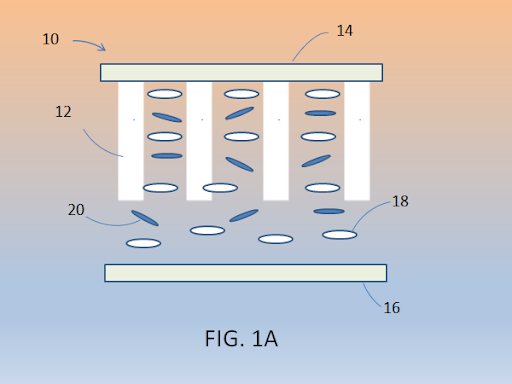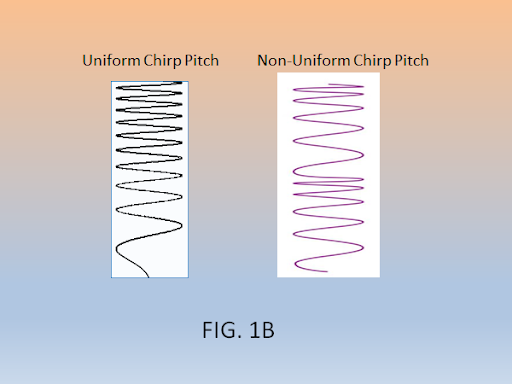
Materials Synthesis
Building the Future
Synthesizing Precision Mixtures for Any Desired Performance
Liquid crystals are eutectic mixtures of many components whose composition will profoundly affect their electro-optic performance. AlphaMicron has explored and created new liquid crystal formulations by tapping into novel components to create materials with new abilities as they relate to light reactivity. To do this, we have had to innovate and test hundreds of new liquid crystal formulations.
We are currently working on converting conventional materials through synthetic modification to enhance their properties and interactions with the other components such as the polyimide, adhesion promoters, hardcoats, conductive layers, and more.
Our Chemistry Group specializes in the design, synthesis, and formulation of ultra-pure organic materials including:
- Liquid crystal mixtures
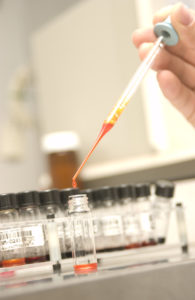
- High performance Dichroic dyes
- High order parameter Photo-Dichroic dyes
- Fast response photochromic systems
- Nematic liquid crystals
- Chiral dopants
- Mesogenic monomers
- Initiators
- LC compatible Laser dyes
The result of our work is a series of uniquely high performance liquid crystal mixtures that can be expertly adapted to solve a number of pressing industry problems. Our materials can achieve a mixture of highly desired parameters in light-reactivity such as light transmission, contrast, reliability, neutrality and solubility. The extraordinary performance of these materials allows us to help develop products that meet the stringent optical specifications for both the government and private sector.
AlphaMicron’s unique material formulations is being licensed and sold to major chemical companies for use in optical industries – but our work is not done! Our development efforts are ongoing and we enjoy hands-on opportunities to solve individual organizations’ pressing challenges through scientific exploration.
Materials Synthesis And Formulation – The Scientific Details
AlphaMicron has active programs in each material development category:
Liquid crystal mixtures are highly complex mixtures of several mesogenic and non-mesogneic molecules as well as chiral dopants, monomers, dyes, and other active dopants. There can be as many as 20 sub-components in any one LC mixture! Each subcomponent has to be specifically matched with other dopants in both chemical structure and concentration to provide the expected optical, thermal and electrical performance needed. Slight deviation or impurity can adversely affect the stability of the mixture and result in undesirable phase separation. Expertise in formulating liquid crystal mixtures comes only after years of experience and testing and is the prime reason why the suppliers of liquid crystalline material are limited.
AlphaMicron has spent over 20 years studying liquid crystal materials and formulations. It has created a library of materials that can be used in various mixtures and catalogued their effects in guest-host systems. To meet the particular requirements needed for a final system, chemists and physicists at AlphaMicron formulate specific mixtures that will precisely meet each requirement to arrive at a final product.

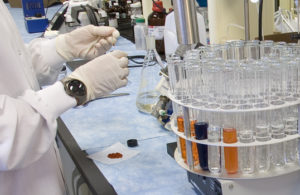 Absorptive LC systems, like AlphaMicron’s e-Tint® technology, are dependent on high order parameter dichroic dyes which are also soluble in the liquid crystal host. We have developed a variety of dichroic dyes with absorption spectra that span the entire visible spectrum. They have been shown to have the highest recorded dichroic ratio. The dyes are used in both positive and negative anisotropy LC hosts resulting in normally-dark or normally-clear systems. They can also be added to scattering or reflective technologies to enhance the overall performance of the system. In addition, they can be used to create multi-color devices. For example, a 4-color system was designed and commercialized. Whether the system is activated with voltage (e-Tint®), temperature (thermochromic), UV light (polarized photochormic), or visible light (configurational azo dyes), the presence of the high purity, high dichroic ratio dyes enhances the performance.
Absorptive LC systems, like AlphaMicron’s e-Tint® technology, are dependent on high order parameter dichroic dyes which are also soluble in the liquid crystal host. We have developed a variety of dichroic dyes with absorption spectra that span the entire visible spectrum. They have been shown to have the highest recorded dichroic ratio. The dyes are used in both positive and negative anisotropy LC hosts resulting in normally-dark or normally-clear systems. They can also be added to scattering or reflective technologies to enhance the overall performance of the system. In addition, they can be used to create multi-color devices. For example, a 4-color system was designed and commercialized. Whether the system is activated with voltage (e-Tint®), temperature (thermochromic), UV light (polarized photochormic), or visible light (configurational azo dyes), the presence of the high purity, high dichroic ratio dyes enhances the performance.
AlphaMicron dyes have met and surpassed the stringent requirements for automotive and military applications. For this reason, we are the suppliers of specialty dichroic dye/LC mixtures for products from military grade electronically switchable eyewear and goggles – to switchable sunroofs, auto-dimming mirrors and windows.
In addition to the liquid crystal and dichroic dye components, a formulation will include a number of dopants that provide functional capabilities to the liquid crystal host. These include chiral dopants, fluorescent dyes, stabilizers and other materials. Chiral dopants are used in many liquid crystal based devices to provide the material with a self-assembled pitch. Depending on this pitch, the optical properties of the system can be altered from a polarization rotator to a reflective polarizer and/or scatterer.For example, we have created UV activated chiral dopants which can alter their chirality upon light illumination.
In addition to making chiral dopants, AlphaMicron synthesizes its own specialized dopants including liquid crystal compatible fluorescent dyes for CLC laser applications and stabilizers that help prolong UV resistance and increase lifetime of the entire mixture.
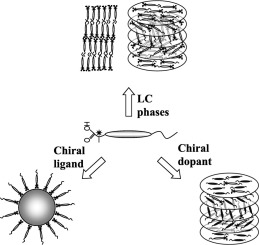
Addition of monomers to liquid crystal systems and subsequent polymerization increases the mechanical stability of the system. Creating polymer networks without affecting the phase of the liquid crystal host is a complex task and depends on both material and process-related parameters. AlphaMicron synthesizes polymerizable monomers that are mesogenic and compatible with the liquid crystalline host. Once polymerized into main chain or side chains, these monomers provide a backbone which can help orient the liquid crystal as well as provide mechanical stability.
More recently, we have synthesized liquid crystal compatible polymerizable chiral dopants. This material imparts chirality to the polymer network during polymerization, which is controllable by the processing conditions. This allows creation of unique structures such as a chirped twisted network used in broadband reflectors and CLC lasers.
In addition, AlphaMicron has created polymerizable photochromic-dichroic dyes which adhere to the network and can be activated by light. These materials have potential as tunable seeds for CW and pulsed lasers, waveguiding, switching and sensing applications.
